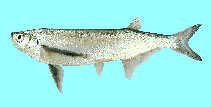Upload your photos and videos
Pictures | Google imagePelecus cultratus
Picture by Otel, V.
Pictures | Google imagePelecus cultratus
Picture by Otel, V.
Lithuania country information
Common names:
Ožka, Ožla
Occurrence: native
Salinity: freshwater
Abundance: common (usually seen) | Ref: Winkler, H.M., K. Skora, R. Repecka, M. Ploks, A. Neelov, L. Urho, A. Gushin and H. Jespersen, 2000
Importance: | Ref:
Aquaculture: | Ref:
Regulations: | Ref:
Uses: no uses
Comments:
National Checklist:
Country Information: https://www.cia.gov/library/publications/resources/the-world-factbook/geos/lh.html
National Fisheries Authority:
Occurrences: Occurrences Point map
Main Ref: Muus, B.J. and P. Dahlström, 1968
National Database:
Occurrence: native
Salinity: freshwater
Abundance: common (usually seen) | Ref: Winkler, H.M., K. Skora, R. Repecka, M. Ploks, A. Neelov, L. Urho, A. Gushin and H. Jespersen, 2000
Importance: | Ref:
Aquaculture: | Ref:
Regulations: | Ref:
Uses: no uses
Comments:
National Checklist:
Country Information: https://www.cia.gov/library/publications/resources/the-world-factbook/geos/lh.html
National Fisheries Authority:
Occurrences: Occurrences Point map
Main Ref: Muus, B.J. and P. Dahlström, 1968
National Database:
Common names from other countries
Classification / Names Nomi Comuni | Sinonimi | Catalog of Fishes(Genere, Specie) | ITIS | CoL | WoRMS | Cloffa
> Cypriniformes (Carps) > Leuciscidae (Minnows) > Leuciscinae
Etymology: Pelecus: Greek, pelekys = hatchet (Ref. 45335).
More on author: Linnaeus.
Etymology: Pelecus: Greek, pelekys = hatchet (Ref. 45335).
More on author: Linnaeus.
Environment: milieu / climate zone / depth range / distribution range Ecologia
; acqua dolce; salmastro pelagico; anadromo (Ref. 51243); distribuzione batimetrica 20 - ? m (Ref. 9696). Temperate; 10°C - 20°C (Ref. 2059); 63°N - 36°N, 8°E - 73°E
Distribuzione Stati | Aree FAO | Ecosystems | Presenze | Point map | Introduzioni | Faunafri
Eurasia: Black Sea, Caspian Sea and Aral Sea basins; Baltic basin from Vistula to Neva drainages, southern Sweden and Finland, Lakes Ladoga and Onega. Occasionally on Baltic coast west of Vistula and on Finnish coast north of 61°N (Ref. 59043).
Length at first maturity / Size / Peso / Age
Maturity: Lm ? range ? - ? cm
Max length : 60.0 cm TL maschio/sesso non determinato; (Ref. 556); common length : 25.0 cm TL maschio/sesso non determinato; (Ref. 556); peso massimo pubblicato: 2.0 kg (Ref. 556); Età massima riportata: 11 anni (Ref. 27368)
Max length : 60.0 cm TL maschio/sesso non determinato; (Ref. 556); common length : 25.0 cm TL maschio/sesso non determinato; (Ref. 556); peso massimo pubblicato: 2.0 kg (Ref. 556); Età massima riportata: 11 anni (Ref. 27368)
Short description Chiavi di identificazione | Morfologia | Morfometria
Mouth oblique. Low wavy lateral line. Belly with a sharp edge (Ref. 35388).
Adults shoal in lower reaches of large rivers and in the eastern Baltic, the Caspian Sea and the Aral Sea. They spawn in spring in midstream (Ref. 9696) and return to estuaries to forage immediately after spawning (Ref. 59043). Juveniles may migrate to estuaries during first summer (Ref. 59043). Feed on zooplankton, terrestrial invertebrates and small fish (Ref. 59043).
Life cycle and mating behavior Maturità | Riproduzione | Deposizione | Uova | Fecundity | Larve
Open water egg scatterers.
Main reference
Upload your references | Bibliografia | Coordinatore | Collaboratori
Muus, B.J. and P. Dahlström, 1968. Süßwasserfische. BLV Verlagsgesellschaft, München. 224 p. (Ref. 556)
Threat to humans
Harmless
Human uses
Pesca: scarso interesse commerciale
FAO(Aquaculture systems: production; pesca: production; publication : search) | FishSource | Sea Around Us
Informazioni ulteriori
Population dynamics
Growth parameters
Max. ages / sizes
Length-weight rel.
Length-length rel.
Length-frequencies
Mass conversion
Reclutamento
Abbondanza
Growth parameters
Max. ages / sizes
Length-weight rel.
Length-length rel.
Length-frequencies
Mass conversion
Reclutamento
Abbondanza
Life cycle
Riproduzione
Maturità
Fecundity
Deposizione
Spawning aggregations
Uova
Egg development
Larve
Dinamica popolazioni larvali
Riproduzione
Maturità
Fecundity
Deposizione
Spawning aggregations
Uova
Egg development
Larve
Dinamica popolazioni larvali
Anatomy
Area branchiale
Brain
Otolith
Area branchiale
Brain
Otolith
Physiology
Body composition
Nutrients
Oxygen consumption
Swimming type
Swimming speed
Visual pigments
Fish sound
Diseases & Parasites
Toxicity (LC50s)
Body composition
Nutrients
Oxygen consumption
Swimming type
Swimming speed
Visual pigments
Fish sound
Diseases & Parasites
Toxicity (LC50s)
Human related
Aquaculture systems
Profili di acquacoltura
Varietà
Ciguatera cases
Stamps, coins, misc.
Aquaculture systems
Profili di acquacoltura
Varietà
Ciguatera cases
Stamps, coins, misc.
Strumenti
E-book | Giuda pratica | Generatore frequenze di lunghezza | Strumento Parametri Biologici | Mappa dei ritrovamenti | Classification Tree
| Catch-MSY |
Special reports
Download XML
Fonti Internet
Alien/Invasive Species database | Aquatic Commons | BHL | Cloffa | BOLDSystems | Websites from users | Check FishWatcher | CISTI | Catalog of Fishes(Genere, Specie) | DiscoverLife | ECOTOX | Faunafri | Fishtrace | GenBank(genome, nucleotide) | GloBI | GOBASE | | Google Books | Google Scholar | Google | IGFA World Record | MitoFish | Database Nazionali | Otolith Atlas of Taiwan Fishes | Acquari pubblici | PubMed | Reef Life Survey | Scirus | SeaLifeBase | Tree of Life | Wikipedia(Go, ricerca) | World Records Freshwater Fishing | Zoological Record
Estimates based on models
Phylogenetic diversity index (Ref. 82804): PD50 = 1.0000 [Uniqueness, from 0.5 = low to 2.0 = high].
Bayesian length-weight: a=0.00724 (0.00358 - 0.01465), b=3.14 (2.97 - 3.31), in cm Total Length, based on LWR estimates for this (Sub)family-body shape (Ref. 93245).
Trophic level (Ref. 69278): 3.6 ±0.53 se; based on food items.
Resilienza (Ref. 120179): Medio, tempo minimo di raddoppiamento della popolazione 1.4 - 4.4 anni (K=0.20; tmax=11).
Fishing Vulnerability (Ref. 59153): Moderate to high vulnerability (50 of 100).




